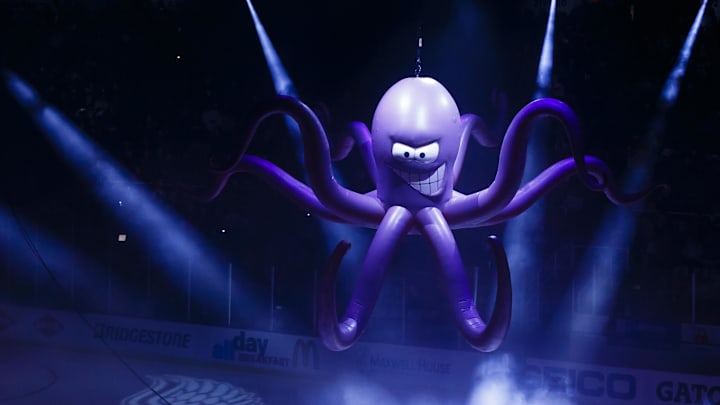It does not matter if you stepped foot in The Joe or Little Caesars Arena. It does not matter if you ever stepped foot in Detroit or even Michigan once in your life. If you are an NHL fan, you know that, from time to time, an octopus finds its way onto the ice at a Red Wings game.
Chances are, if you are a hardcore Red Wings fan, you know the story. On the other hand, a new or casual fan might not know why this happens. It certainly is a unique tradition that has never been rivaled at any other home of hockey. The tradition and the story behind it reached legendary status, and the team and the octopod are symbolically intertwined.
One might even go as far as naming their site after it. *cough*
So, maybe this story is not for you, dedicated fan. However, as the sport reaches a new generation of hockey enthusiasts, the legend must be passed on to stay alive, especially since a direct link to the tradition is gone forever.
A fishy history
Pete and Jerry Cusimano were brothers and fishmongers. They owned a spot in Detroit’s Eastern Market and, though their business has faded into obscurity, a piece of its inventory made it into infamy.
In the 1952 NHL Stanley Cup Semi-Finals, the Detroit Red Wings swept the defending Stanley Cup champions, the Toronto Maple Leafs. However, the Wings were no slouches. The team notched its fourth championship the season prior to the Leafs, 1949-50.
That series, the Detroit shut out the Leafs twice and held them to three total goals over the final two games. It was a thorough dismantling of a storied franchise.
After the sweep, Detroit awaited the outcome of Montreal Canadiens and Boston Bruins series. The victor would face them in the Stanley Cup finals. Montreal edged out Boston in game seven of their matchup.
A tradition begins
The Red Wings easily handled the Canadiens in the first three games of the series. Game four took place on Tuesday, April 15. Goaltender Terry Sawchuck allowed only two goals in the previous three games, and he showed no signs of slowing down.
The crowd was electric. The team was firing on all cylinders. There was something in the air that night. It was the stench of octopus. According to the Detroit Free Press but via :
Jerry supposedly picked up a leg and gestured to his brother. As Pete recalled in the Detroit Free Press years later, he remembers Jerry saying, “Here’s the thing with eight legs. Why don’t we throw it on the ice and maybe the Wings’ll win eight straight?”
One wonders how an octopus found its way into the stadium and the stands.
In 1952, the playoffs consisted of two series, requiring eight total wins to secure a Stanley Cup championship. So, winning eight straight did not seem like much of a stretch, as they already had seven of those wins down going into game four.
That night, the brothers snuck an octopus into Detroit’s home stadium, Olympia, and waited for the right moment to make their move. Under seven minutes into the first, Metro Prystai opened the scoring with a powerplay goal. Pete allegedly made his move and, for the first time in recorded history, an octopus made a Stanley Cup appearance.
A Stanley Cup championship
The game-winning goal had already been scored by then, though nobody knew it at the time. Glen Skov potted an insurance goal at the end of the second, and Prystai added another in the third. He factored into all three of the goals.
Neither the Cusimanos nor the mollusk won any awards that night for their bravery, though the incident became an instant sign of good luck. The team won Lord Stanley’s Cup again in 1951-52, 1953-54, and 1954-55.
Unfortunately, the Dead Wings era began in 1967, and playoff appearances eluded the team and opportunities to toss an octopus vanished.
In the late 80s, the team began making its way back into the playoffs and the organization worked to bring the tradition back. To help, they partnered with Superior Fish Company to become the official source for playoff octopods.
A new mascot
The Red Wings adopted the mollusk as its unofficial mascot and named it Al after the Red Wings’ buildings operations manager and Zamboni driver, Al Sobotka. He oversaw removing the discarded sea creatures from the ice.
Sobotka began twirling the octopus above his head as he made his way across the ice. The league banned swinging the octopus with the penalty of a $10,000 fine, but it wasn’t long before they let up.
During the Red Wings last game at Joe Louis Arena, fans threw 35 octopuses onto the ice. That must have been fun to clean up.
A cartoonish octopus hung from the rafters at the arena. During the playoffs, a second was added to symbolize the 16 games now needed to win a Cup.
Nearly 75 years later, the Red Wings tradition continues to be an important part of Red Wings history, with the actual octopus shadowing the mascot itself.
